2014 FIAT BRAVO maintenance
[x] Cancel search: maintenancePage 108 of 275

When reverse gear is released, the front and rear
sensors remain activated until a speed of around 15
km/h is exceeded to allow the parking manoeuvre to
be completed.
The system can also be activated by pressing the
button
fig. 96 in the central panel: a warning light
in the button comes on when the system is
activated.
Every time the ignition key is turned to MAR-ON
the LED on the button
flashes briefly to indicate
that the system is running a diagnosis. The LED
activation should not be understood as a fault.
The sensors are deactivated by pressing the button
again
fig. 96 or when a speed of 15 km/h is
exceeded: the warning light in the button is off when
the system is not active.
When the sensors are activated, the system starts to
produce acoustic signals from the front or rearbuzzers as soon as an obstacle is detected with the
frequency increasing as the obstacle gets closer.
When the obstacle is less than about 30 cm away,
the sound becomes continuous. Depending on
the position of the obstacle (in front or behind) the
sound is produced by the corresponding buzzers
(front or rear). The obstacle closest to the vehicle is
signalled.
The acoustic signal stops immediately if the distance
of the obstacle increases. The sound cycle remains
constant if the distance measured by the centre
sensors remains unchanged, while if this situation
occurs for the side sensors, the signal is interrupted
after about 3 seconds (for example, to prevent
signals in the case of manoeuvres alongside walls).
WARNING
Parking and other dangerous
manoeuvres however are always the
driver ’s responsibility.When making these
manoeuvres, always make sure that no people
(especially children) or animals are present
in your manoeuvring space.The parking sensors
are designed to assist drivers: in any case, you
must always pay the utmost attention during
potentially dangerous manoeuvres, even when
carried out at low speed.
fig. 96
F0Q0035
104GETTING TO
KNOW YOUR CAR
SAFETY
STARTING AND
DRIVING
WARNING LIGHTS
AND MESSAGES
IN AN EMERGENCY
SERVICING AND
MAINTENANCE
TECHNICAL
SPECIFICATIONS
INDEX
Page 109 of 275

ACOUSTIC SIGNAL
The information concerning the presence and
distance of an obstacle from the vehicle is
transmitted by means of acoustic signals from
buzzers installed in the passenger compartment:
❒in the versions with 4 rear sensors, a buzzer in the
front dashboard area warns of the presence of rear
obstacles;
❒in the versions with 8 sensors (4 front and 4 rear
sensors), a front buzzer warns of the presence of
obstacles at the front and a buzzer located at
the rear warns of the presence of obstacles at the
rear. This notifies the driver of the direction
(front/rear) of the obstacles.
When reverse gear is engaged an intermittent
acoustic signal is automatically activated.
The acoustic signal:
❒increases as the distance between the car and the
obstacle decreases;
❒becomes continuous when the distance between
the car and the obstacle is less than 30 cm and
stops immediately if the distance increases;
❒remains constant if the distance remains
unchanged; if this situation concerns the side
sensors, the buzzer will stop after about 3 seconds
to avoid, for example, warning indications in the
event of manoeuvres along walls.
WARNING
For correct operation, sensors must
always be clean from mud, dirt , snow or
ice. Be careful not to scratch or damage the
sensors while cleaning them. Avoid using dry,
rough or hard cloths.The sensors should be
washed using clean water with the addition of
car shampoo if necessary. In washing stations,
clean sensors quickly keeping the vapour
jet/high pressure washing nozzles at 10 cm at
least from the sensors.
WARNING
Only have the bumpers repainted or any
retouches to the paintwork in the area
of the sensors carried out by a Fiat Dealership.
Incorrect paint application could affect the
operation of the parking sensors.
105GETTING TO
KNOW YOUR CARSAFETY
STARTING AND
DRIVING
WARNING LIGHTS
AND MESSAGES
IN AN EMERGENCY
SERVICING AND
MAINTENANCE
TECHNICAL
SPECIFICATIONS
INDEX
Page 110 of 275
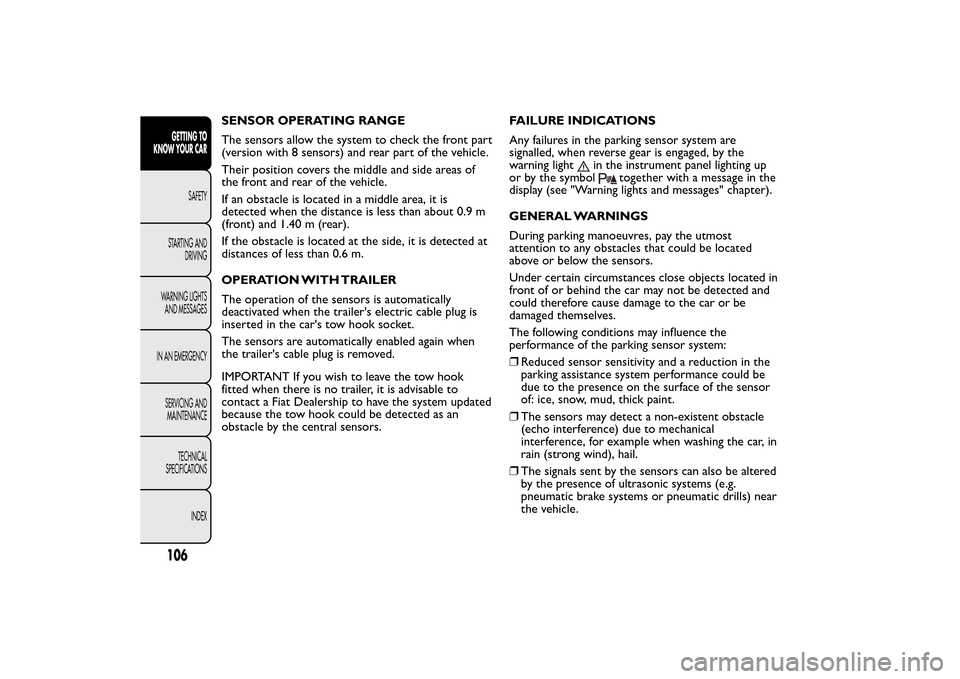
SENSOR OPERATING RANGE
The sensors allow the system to check the front part
(version with 8 sensors) and rear part of the vehicle.
Their position covers the middle and side areas of
the front and rear of the vehicle.
If an obstacle is located in a middle area, it is
detected when the distance is less than about 0.9 m
(front) and 1.40 m (rear).
If the obstacle is located at the side, it is detected at
distances of less than 0.6 m.
OPERATION WITH TRAILER
The operation of the sensors is automatically
deactivated when the trailer's electric cable plug is
inserted in the car's tow hook socket.
The sensors are automatically enabled again when
the trailer's cable plug is removed.
IMPORTANT If you wish to leave the tow hook
fitted when there is no trailer, it is advisable to
contact a Fiat Dealership to have the system updated
because the tow hook could be detected as an
obstacle by the central sensors.FAILURE INDICATIONS
Any failures in the parking sensor system are
signalled, when reverse gear is engaged, by the
warning light
in the instrument panel lighting up
or by the symbol
together with a message in the
display (see "Warning lights and messages" chapter).
GENERAL WARNINGS
During parking manoeuvres, pay the utmost
attention to any obstacles that could be located
above or below the sensors.
Under certain circumstances close objects located in
front of or behind the car may not be detected and
could therefore cause damage to the car or be
damaged themselves.
The following conditions may influence the
performance of the parking sensor system:
❒Reduced sensor sensitivity and a reduction in the
parking assistance system performance could be
due to the presence on the surface of the sensor
of: ice, snow, mud, thick paint.
❒The sensors may detect a non-existent obstacle
(echo interference) due to mechanical
interference, for example when washing the car, in
rain (strong wind), hail.
❒The signals sent by the sensors can also be altered
by the presence of ultrasonic systems (e.g.
pneumatic brake systems or pneumatic drills) near
the vehicle.
106GETTING TO
KNOW YOUR CAR
SAFETY
STARTING AND
DRIVING
WARNING LIGHTS
AND MESSAGES
IN AN EMERGENCY
SERVICING AND
MAINTENANCE
TECHNICAL
SPECIFICATIONS
INDEX
Page 111 of 275
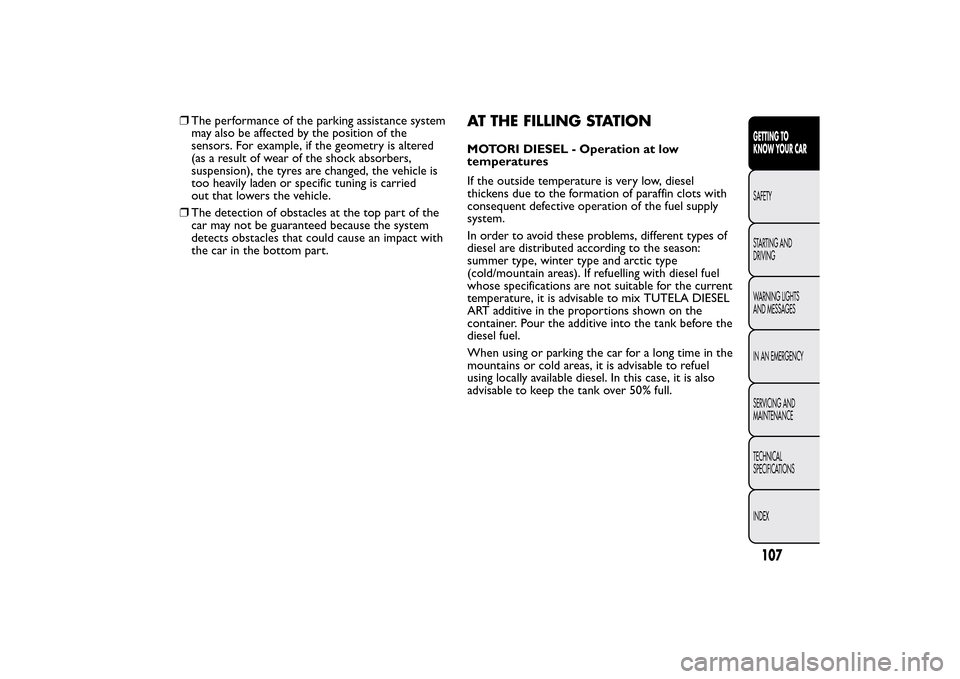
❒The performance of the parking assistance system
may also be affected by the position of the
sensors. For example, if the geometry is altered
(as a result of wear of the shock absorbers,
suspension), the tyres are changed, the vehicle is
too heavily laden or specific tuning is carried
out that lowers the vehicle.
❒The detection of obstacles at the top part of the
car may not be guaranteed because the system
detects obstacles that could cause an impact with
the car in the bottom part.
AT THE FILLING STATIONMOTORI DIESEL - Operation at low
temperatures
If the outside temperature is very low, diesel
thickens due to the formation of paraffin clots with
consequent defective operation of the fuel supply
system.
In order to avoid these problems, different types of
diesel are distributed according to the season:
summer type, winter type and arctic type
(cold/mountain areas). If refuelling with diesel fuel
whose specifications are not suitable for the current
temperature, it is advisable to mix TUTELA DIESEL
ART additive in the proportions shown on the
container. Pour the additive into the tank before the
diesel fuel.
When using or parking the car for a long time in the
mountains or cold areas, it is advisable to refuel
using locally available diesel. In this case, it is also
advisable to keep the tank over 50% full.
107GETTING TO
KNOW YOUR CARSAFETY
STARTING AND
DRIVING
WARNING LIGHTS
AND MESSAGES
IN AN EMERGENCY
SERVICING AND
MAINTENANCE
TECHNICAL
SPECIFICATIONS
INDEX
Page 112 of 275
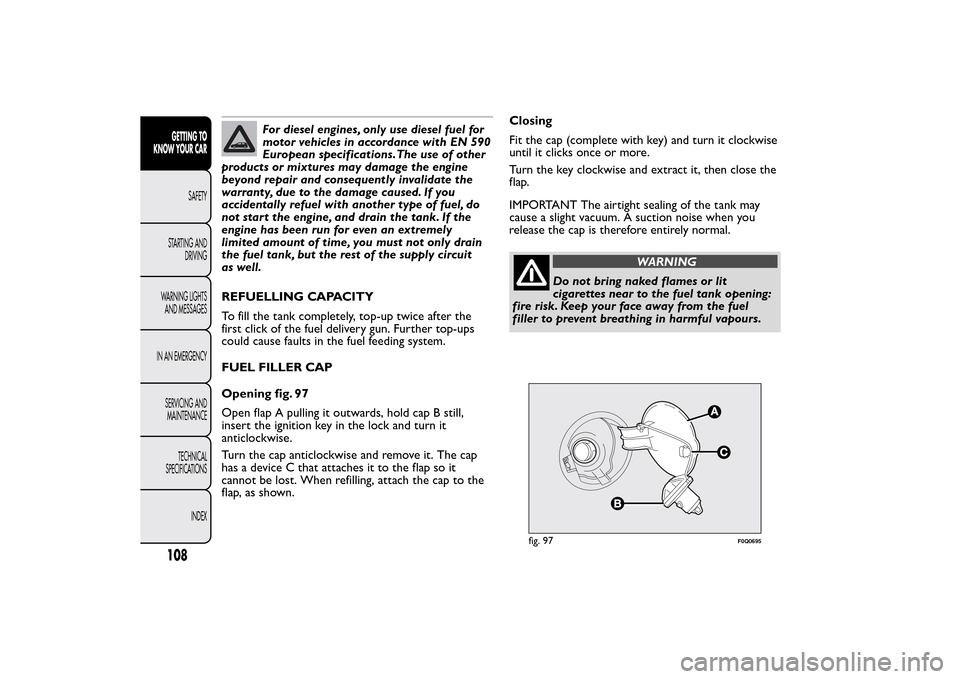
For diesel engines, only use diesel fuel for
motor vehicles in accordance with EN 590
European specifications.The use of other
products or mixtures may damage the engine
beyond repair and consequently invalidate the
warranty, due to the damage caused. If you
accidentally refuel with another type of fuel, do
not start the engine, and drain the tank. If the
engine has been run for even an extremely
limited amount of time, you must not only drain
the fuel tank, but the rest of the supply circuit
as well.
REFUELLING CAPACITY
To fill the tank completely, top-up twice after the
first click of the fuel delivery gun. Further top-ups
could cause faults in the fuel feeding system.
FUEL FILLER CAP
Opening fig. 97
Open flap A pulling it outwards, hold cap B still,
insert the ignition key in the lock and turn it
anticlockwise.
Turn the cap anticlockwise and remove it. The cap
has a device C that attaches it to the flap so it
cannot be lost. When refilling, attach the cap to the
flap, as shown.Closing
Fit the cap (complete with key) and turn it clockwise
until it clicks once or more.
Turn the key clockwise and extract it, then close the
flap.
IMPORTANT The airtight sealing of the tank may
cause a slight vacuum. A suction noise when you
release the cap is therefore entirely normal.
WARNING
Do not bring naked flames or lit
cigarettes near to the fuel tank opening:
fire risk. Keep your face away from the fuel
filler to prevent breathing in harmful vapours.
fig. 97
F0Q0695
108GETTING TO
KNOW YOUR CAR
SAFETY
STARTING AND
DRIVING
WARNING LIGHTS
AND MESSAGES
IN AN EMERGENCY
SERVICING AND
MAINTENANCE
TECHNICAL
SPECIFICATIONS
INDEX
Page 113 of 275

PROTECTING THE ENVIRONMENTThe following devices are used for reducing diesel
fuel engine emissions:
❒oxidising catalytic converter
❒exhaust gas recirculation system (EGR)
❒particulate filter (DPF).
WARNING
Under normal operating conditions, the
silencer becomes very hot .Therefore
do not park the car on flammable materials
(grass, dry leaves, pine needles, etc .): fire
hazard.
DIESEL PARTICULATE FILTER (DPF)
(for versions/markets, where provided)
The Diesel Particulate Filter is a mechanical filter,
integral with the exhaust system, that physically traps
particulates present in the exhaust gases of diesel
engines. The diesel particulate filter has been
adopted to eliminate almost all particulates in
compliance with current / future legal regulations.
During normal use of the vehicle, the engine control
unit records a set of data (e.g.: travel time, type of
route, temperatures, etc.) and it will then calculate
how much particulate has been trapped by the filter.Since this filter physically traps particulate, it should
be regenerated (cleaned) at regular intervals by
burning the carbon particles. The regeneration
procedure is controlled automatically by the engine
management control unit according to the filter
conditions and vehicle use conditions. There may be
a limited increase in the engine speed during the
regeneration, a limited increase in fumes and high
temperatures at the exhaust. These are not faults;
they do not impair vehicle performance or damage
the environment.
Particulate filter clogged
If the warning light switches on on the instrument
panel (along with the message on the display) refer
to the "Warning lights and messages" chapter.
109GETTING TO
KNOW YOUR CARSAFETY
STARTING AND
DRIVING
WARNING LIGHTS
AND MESSAGES
IN AN EMERGENCY
SERVICING AND
MAINTENANCE
TECHNICAL
SPECIFICATIONS
INDEX
Page 114 of 275
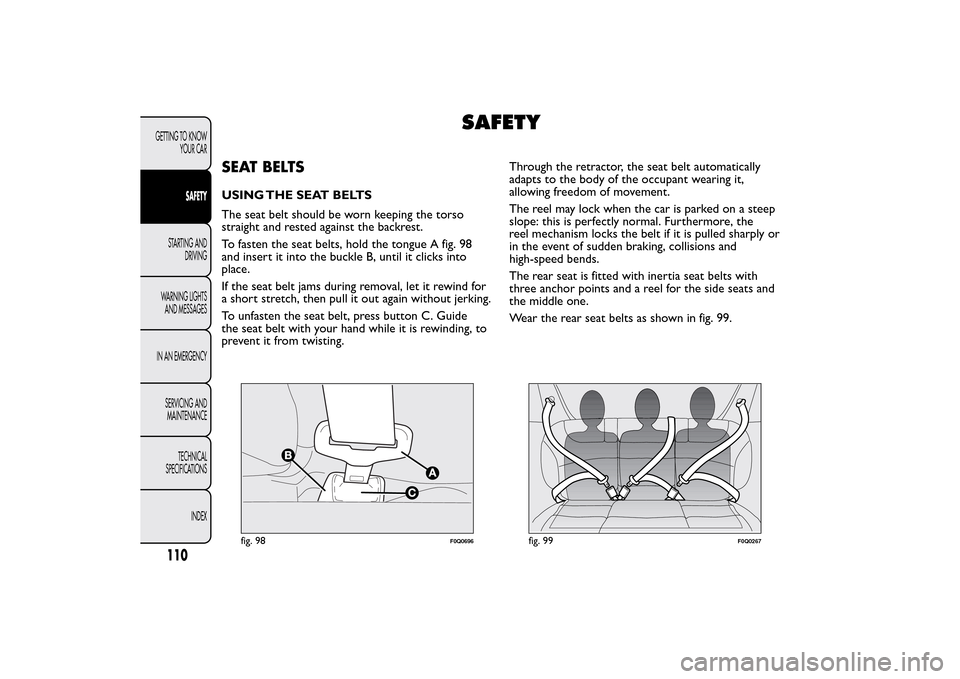
SAFETY
SEAT BELTSUSING THE SEAT BELTS
The seat belt should be worn keeping the torso
straight and rested against the backrest.
To fasten the seat belts, hold the tongue A fig. 98
and insert it into the buckle B, until it clicks into
place.
If the seat belt jams during removal, let it rewind for
a short stretch, then pull it out again without jerking.
To unfasten the seat belt, press button C. Guide
the seat belt with your hand while it is rewinding, to
prevent it from twisting.Through the retractor, the seat belt automatically
adapts to the body of the occupant wearing it,
allowing freedom of movement.
The reel may lock when the car is parked on a steep
slope: this is perfectly normal. Furthermore, the
reel mechanism locks the belt if it is pulled sharply or
in the event of sudden braking, collisions and
high-speed bends.
The rear seat is fitted with inertia seat belts with
three anchor points and a reel for the side seats and
the middle one.
Wear the rear seat belts as shown in fig. 99.
fig. 98
F0Q0696
fig. 99
F0Q0267
110GETTING TO KNOW
YOUR CAR
SAFETY
STARTING AND
DRIVING
WARNING LIGHTS
AND MESSAGES
IN AN EMERGENCY
SERVICING AND
MAINTENANCE
TECHNICAL
SPECIFICATIONS
INDEX
Page 115 of 275
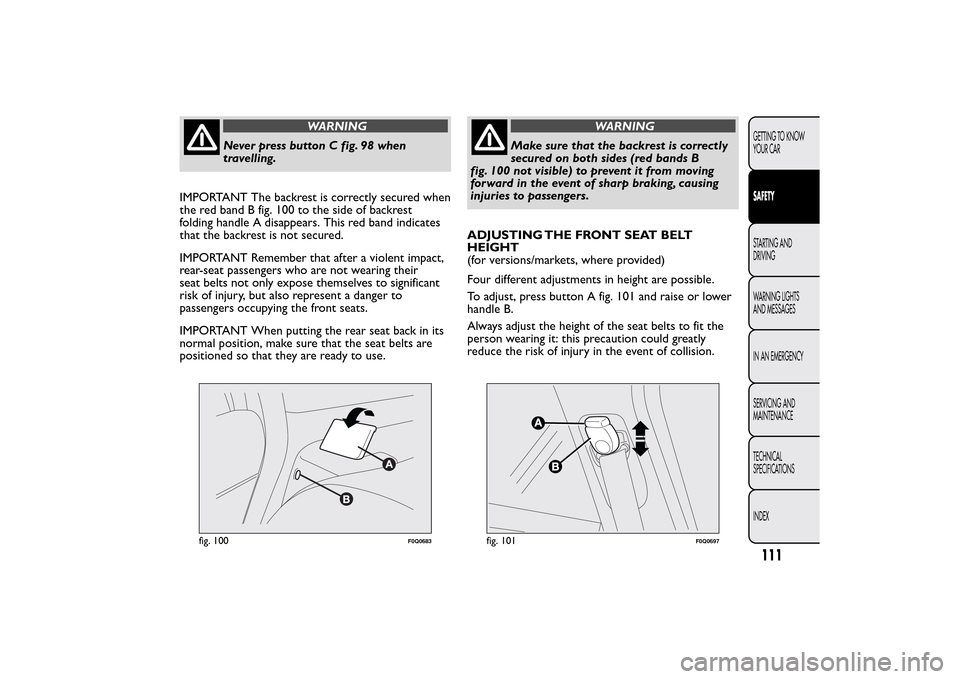
WARNING
Never press button C fig. 98 when
travelling.
IMPORTANT The backrest is correctly secured when
the red band B fig. 100 to the side of backrest
folding handle A disappears. This red band indicates
that the backrest is not secured.
IMPORTANT Remember that after a violent impact,
rear-seat passengers who are not wearing their
seat belts not only expose themselves to significant
risk of injury, but also represent a danger to
passengers occupying the front seats.
IMPORTANT When putting the rear seat back in its
normal position, make sure that the seat belts are
positioned so that they are ready to use.
WARNING
Make sure that the backrest is correctly
secured on both sides (red bands B
fig. 100 not visible) to prevent it from moving
forward in the event of sharp braking, causing
injuries to passengers.
ADJUSTING THE FRONT SEAT BELT
HEIGHT
(for versions/markets, where provided)
Four different adjustments in height are possible.
To adjust, press button A fig. 101 and raise or lower
handle B.
Always adjust the height of the seat belts to fit the
person wearing it: this precaution could greatly
reduce the risk of injury in the event of collision.
fig. 100
F0Q0683
fig. 101
F0Q0697
111GETTING TO KNOW
YOUR CARSAFETYSTARTING AND
DRIVING
WARNING LIGHTS
AND MESSAGES
IN AN EMERGENCY
SERVICING AND
MAINTENANCE
TECHNICAL
SPECIFICATIONS
INDEX